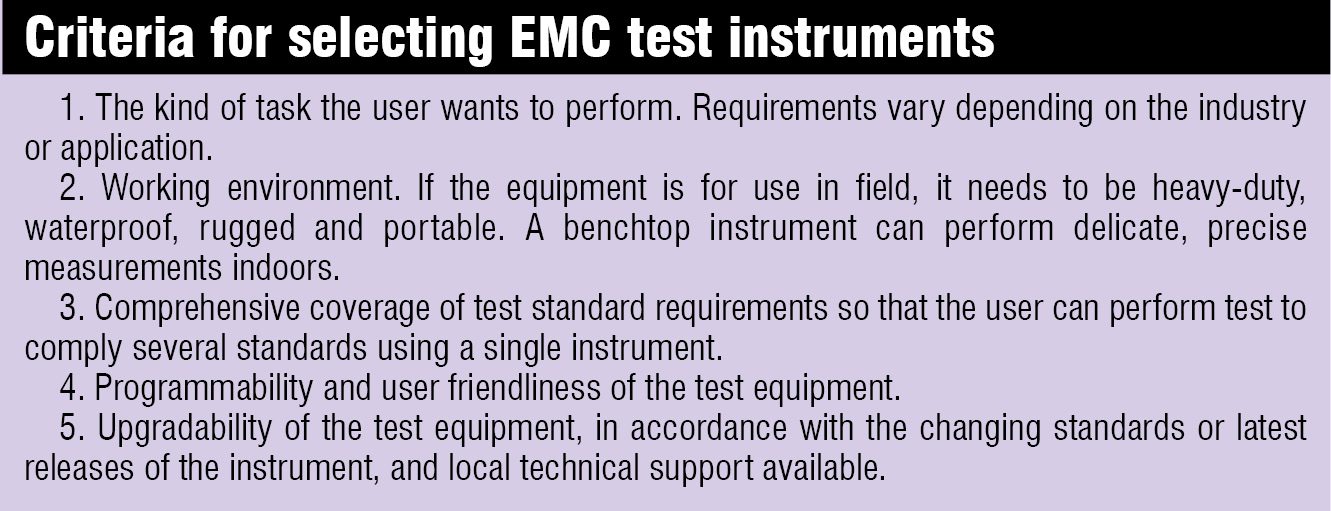“Specifically for the changing compliance standards, we proactively reach out to the designated authorities to know about the likely future compliance changes,” says Raghu Rao, manager of application engineering team of Tektronix India. “This helps in being ahead in the market with future ready solutions.”
Building a basic EMC troubleshooting kit
Troubleshooting is the process of isolating a problem and applying appropriate fixes. A test engineer diagnoses an EMI/EMC problem the same way a doctor diagnoses the medical condition of a patient. The diagnosis involves several stages: looking at clues, examining the equipment, gathering additional information (usually through tests) and finding a suitable solution.

An EMC troubleshooting kit is of great help to both independent and in-house EMC consultants. The essential tools for EMC troubleshooting depend on the kind of industry compliance the customer is looking for. But here is a brief guide that would help you assemble the most basic equipments required for basic troubleshooting, depending on your requirements, at minimum possible cost. The kit can be used for limited pre-compliance testing and assessing radiated emissions.
Spectrum analyser. The heart of an EMC troubleshooting kit is a spectrum analyser. Look for an instrument that is not bulky, preferably a handheld analyser, as it would be easier to carry around. It should have good external command support, fast triggering speed and a capability to buffer many triggered measurements (gated sweep). More useful, if you can afford, is real-time spectrum analyser. Conventional EMC testing involves analysing events that are repetitive. The need for today’s equipment is to be able to catch sporadic and rarely occurring events.
Probes. These include near-field probes and current probes. Probes can be constructed in lab with a little expertise in the field. H-field and E-field probes are near-field RF probes, constructed from semi-rigid coaxial cables, that are used to identify the source of electromagnetic interference emissions and potential radiation frequencies around circuits, cables and enclosures.
H-field probes are made basically from a conductive loop, and they detect magnetic fields produced by clock signals, control signals, serial data streams and switchers. A voltage is produced in the loop proportional to the magnetic field perpendicular to it. With larger size of loops you get higher sensitivity, but lower resolution. E-field probes, which make direct contact with the circuit, are used to find emissions on individual pins or PCB traces.
Poorly-bonded cables are said to be the major cause of radiated emission failures. A current probe, one of the most used accessories in troubleshooting, lets you measure the common-mode current flowing in wires or cables and identify a bad termination, which causes current leakage. Probes let you predict whether the given object will pass the emission test or not. For troubleshooting, high accuracy is not necessary, so you may go for low-cost probes or make your own current probes.
Antenna. A simple TV antenna positioned one or two metres away from the DUT would pick up harmonic signals. Connect it to the spectrum analyser to assess radiated emission. Changes below 2dB could be considered as measurement or setup error. Fixing the antenna in place using tape will reduce additional variables in measurement.
Preamplifier. A broadband preamplifier is used when the signal measured by the probes (particularly the smaller H-field probes) needs to be boosted in order to observe changes in emission levels.
ESD simulator. Electrostatic discharge (ESD) simulator or ESD gun generates ESD pulses that help verify the immunity of a particular device to static electricity discharges. While an actual ESD simulator can be expensive, you can create a rather simple ESD generator using a zipper storage bag with several coins inside. Shake this bag near the circuit to get several volts of ESD pulses at rise times of about 100 picoseconds.
ESD detector. Issues like loss of data and unusual circuit reset can be due to ESD in the circuit. Commercial ESD detectors are available in the market for higher accuracy applications. But an AM broadcast radio tuned off-station can act as a good ESD detector. If it has an FM receiver, you can even tune in product harmonics from radiated emissions.
Radiated immunity testing. Nothing can replace the test lab equipment for accurate radiated immunity levels. But a variable-RF signal generator would allow the simulation of radiated immunity test to some degree and give you an idea of whether the object is immune or not. Once the susceptible region is identified, you can implement potential fixes. This can save time and money as opposed to performing troubleshooting at test labs.










